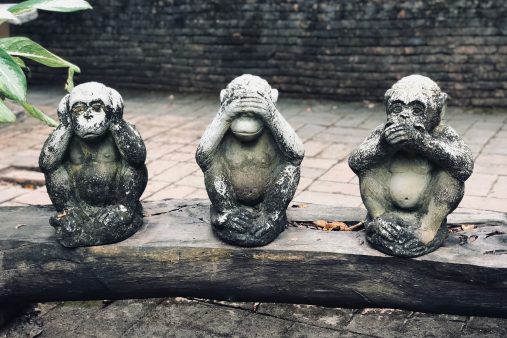Our warped geometry of attention and trust: The mutually exploitative relationship between anti-vaxxers and the far right is undermining public health
28 June 2021
Over the last half decade, I’ve been monitoring the discourse on Twitter about vaccines and immunization. For a while, this was one of the few polarized debates that wasn’t politically polarized. The ranks of anti-vaxxers included lefties skeptical of Big Pharma, hippies distrustful of anything that isn’t “natural,” cultural conservatives who opposed the human papillomavirus (HPV) vaccine because OMG SEX, religious conspiracy theorists who thought that vaccinations might be the “mark of the beast” from the book of Revelation, and of course grifters who hawked alternative medicine to gullible parents.
In recent years, the shape of this network has morphed in response to content moderation by Twitter, which makes an effort to shut down accounts that repeatedly spread medical misinformation. The grifters could no longer get away with blatant lies and untruths like “Vaccines cause autism.” Some of them no doubt gave up or migrated to other platforms. However, others decided to use the political far right for political cover. Instead of making demonstrably false medical claims that rationalized their policy preferences, they framed their message in terms of values, especially the value of freedom. Instead of “Vaccines cause autism,” they started saying things like “The government shouldn’t be allowed to force or pressure me to vaccinate my children.” There are few things that the far right likes better than to insist that no one — especially the government — call tell them what to do, so they made natural allies for the anti-vaxxers, as indicated by the increase in retweets between accounts associated with these two communities.
When the COVID-19 pandemic struck, these groups had already established patterns of mutual attention and trust. That reciprocal relationship of attention and trust was only exacerbated by the pandemic and by former American President Trump’s firehose of medical misinformation, much of which was adopted and amplified by Republican partisans who flooded in. Figure 1 represents the retweet network of the vaccine discourse on Twitter during the first six months of the pandemic.

Figure 1: Retweet networks before (left) and after (right) the WHO pandemic declaration. Blue = Democrats, yellow = public health, black = anti-vaxxers, red = Republicans, green = unorthodox.
The volume of vaccine discourse massively increased after the World Health Organization (WHO) declared a pandemic on 11 March 2020. At the same time, the connections between anti-vaxxers and Republicans intensified, as did those between public health officials and Democrats. What we see here is a pattern of local depolarization in the context of global polarization. In other words, at each end of the two poles (anti-vaxxers/Republicans, public health/Democrats) communities grew closer to one another while the two poles themselves grew further apart.
This impression is further borne out by an analysis of the language used by these communities before and after the pandemic declaration. Figure 2 depicts the similarities of the moral and non-moral language used by all five communities before and after the pandemic was declared.

Figure 2: Dendrograms for LIWC-specific and moral dictionaries pre- and post-pandemic declaration. Distance is based on cosine similarity.
As Figure 2 shows, prior to the pandemic declaration, Republicans and Democrats used a lot of the same moral and non-moral language (even though they didn’t agree with each other), and anti-vaxxers and public health officials used a lot of the same moral and non-moral language (even though they didn’t agree with each other). There was a political discourse about vaccines and a health discourse about vaccines. However, after the declaration and the flooding by Republicans, this pattern was reshuffled: the language used by anti-vaxxers and Republicans grew closer together, while the language used by public health officials and Democrats grew closer together. In other words, the pre-existing patterns of attention and trust in the network seem to have preceded and even directed the evolution of the thinking, expression, and values of the members of these communities. If you were a Republican connected to an anti-vaxxer, you became more like an anti-vaxxer (and vice-versa); if you were a Democrat connected to a public health official, you became more like a public health official (and vice-versa).
The dynamics of this pattern suggest that neither evidence nor values are at the root of the beliefs people adopt, at least when it comes to vaccines. If evidence had priority, people would treat as allies those who published objectively reliable information. If values had priority, they would treat as allies those who published information that expressed moral concerns consonant with their own. In our data, neither of these occurs. Instead, people seem to be treating as allies whoever they antecedently trusted, regardless of whether the trusted individual publishes objectively reliable information or even moral concerns consonant with their own. Indeed, they seem willing to reshape their own values to match those of their trusted partners.
Philosophers who are a bit pessimistic and cynical about human epistemic rationality might be unsurprised by the fact that evidence doesn’t take priority. However, the fact that values also don’t take priority may come as a surprise, especially to those who are familiar with Haidt’s Social Intuitionism and Moral Foundations Theory. These views posit that people are driven by automatic affective reactions rooted in stable moral concerns (“foundations”). To the contrary, we find — using Haidt’s own Moral Foundations Dictionary, which underlies the analysis in Figure 2 —that people are perfectly happy to shift their attachment to moral foundations if their trusted allies differ from them on those foundations.
If this is right, then we need to come to a better understanding of the dynamics of the geometry of attention and trust. Left largely unregulated, these dynamics have led to feedback loop of mutual exploitation anti-vaxxers and the far right in the United States (and elsewhere — our dataset is global, though primarily Anglophone). Without a course correction, vaccine skepticism and hesitancy may render herd immunity unachievable. A recent poll found that fewer than half of self-identified Republicans reported that they intended to be vaccinated against COVID-19 when possible. Social epistemic problems threaten to become medical and moral problems.
The research summarized in this post is from a joint project with Ignacio Ojea Quintana (ANU), Colin Klein (ANU), Marc Cheong (U Melbourne), Amir Ebrahimi Fard (TU-Delft), Emily Sullivan (TU-Eindhoven), and Ritsaart Reimann (Macquarie). This project was made possible through the support of a grant from the John Templeton Foundation (#61378) and the Australian Research Council (DP1901011507). The opinions expressed in this publication are those of the author(s) and do not necessarily reflect the views of the John Templeton Foundation.
Photo by Joao Tzanno on Unsplash
- July 2024
- June 2024
- May 2024
- April 2024
- March 2024
- February 2024
- January 2024
- December 2023
- November 2023
- October 2023
- September 2023
- August 2023
- July 2023
- June 2023
- May 2023
- April 2023
- March 2023
- February 2023
- January 2023
- December 2022
- November 2022
- October 2022
- September 2022
- August 2022
- July 2022
- June 2022
- May 2022
- April 2022
- March 2022
- February 2022
- January 2022
- December 2021
- November 2021
- October 2021
- September 2021
- August 2021
- July 2021
- June 2021
- May 2021
- April 2021
- March 2021
- February 2021
- January 2021
- December 2020
- November 2020
- October 2020
- September 2020
- August 2020
- July 2020
- June 2020
- May 2020
- April 2020
- March 2020
- February 2020
- January 2020
- December 2019
- November 2019
- October 2019
- September 2019
- August 2019
- July 2019
- June 2019
- May 2019
- April 2019
- March 2019
- February 2019
- January 2019
- December 2018
- November 2018
- October 2018
- September 2018
- August 2018
- July 2018
- June 2018
- May 2018
- April 2018
- March 2018
- February 2018
- January 2018
- December 2017
- November 2017
- October 2017
- September 2017
- August 2017
- July 2017
- June 2017
- May 2017

